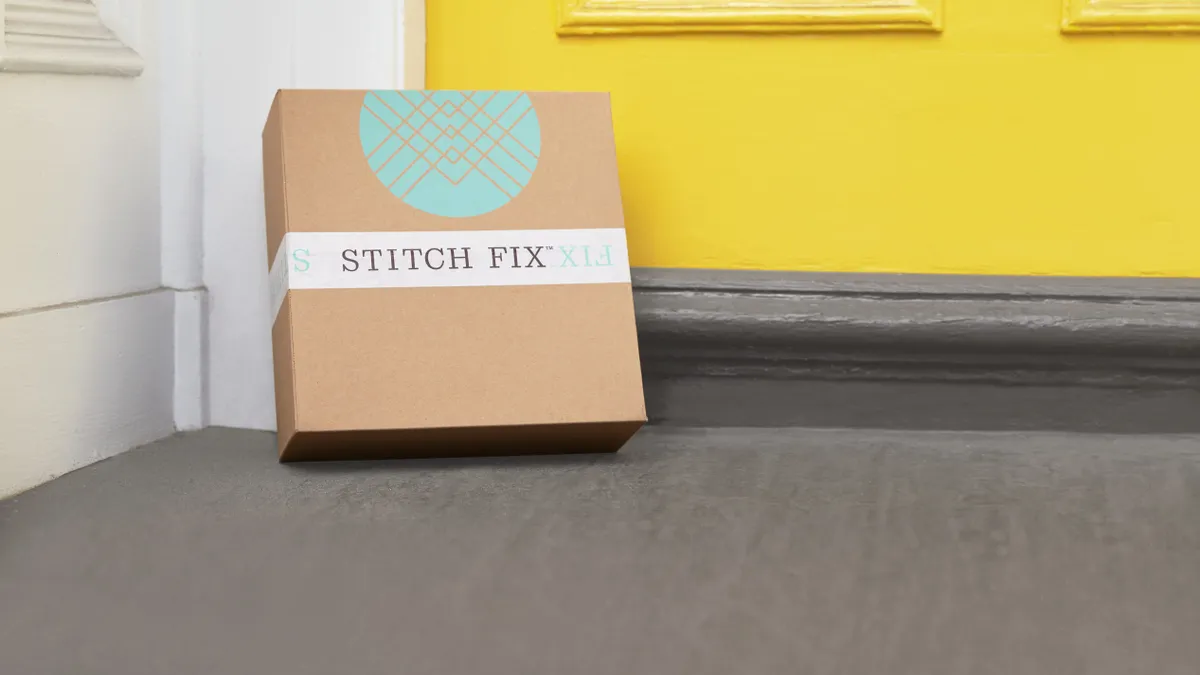Stitch Fix is facing turmoil among its stylist ranks after instituting stricter scheduling and other rules, which has raised concerns for at least one group of analysts.
Many stylists, speaking on condition of anonymity out of fear for their employment or payment status, say the changes make the job untenable. The company likely underestimated how many stylists would opt to take a $1,000 exit payment rather than stick around, according to a client note from Wells Fargo analysts. That and a delay in expanding the company's new "direct buy" feature to new clients are "red flags," Wells Fargo also said.
The company didn't immediately respond to questions about how many stylists have given notice. In a statement, a spokesperson said by email: "Our Stylists are instrumental in building relationships with clients and creating the highly personalized experience Stitch Fix is known for. Like any company, as our clients' needs evolve, we continue to look at ways in which we can better serve them."
Stitch Fix has long described itself as a styling service rather than a traditional apparel retailer, touting the strength of its personalization, forged with a combination of its algorithms and the input of human stylists.
After an initial style quiz, customers receive boxes of apparel items and accessories for $20 per box, in a cadence of their choosing. The contents of a box are determined by a combination of algorithm and stylist input. If the customer keeps zero items, the company keeps the $20 as a "styling fee;" otherwise the money goes toward the customer's purchase. Stitch Fix has added a "fix preview" feature that allows customers to select or reject proposed items before they're mailed and customers can "direct buy" from the site themselves without involving stylists or boxes.
In her day one blog post, written as she took the helm early this month, CEO Elizabeth Spaulding reiterated the power of personalization, saying that at Stitch Fix it involves "improving each of our clients' lives through creative human touch plus data science; a team who struck me as humble, curious and hungry."
A few weeks into her tenure as CEO, many on that team say they are feeling unappreciated, however. Stylists are demanding more information, filling up employment review site Glassdoor with complaints (a problem cited by Wells Fargo) and, in many cases, quitting. Longtime stylists say it's a change from the company's earlier days. Stitch Fix was founded in 2011 and went public in 2017.
"It used to be very customer- and stylist-centric," one stylist, who is leaving after working there for five years, said by phone. "They've used the phrase 'stylists are the heartbeat of the company' so many times, but at the same time don't ever care to listen to stylists, don't value their input. I've worked at very large organizations, and I've never seen communications put out with so little transparency. I think they take advantage of the fact that most people are stay-at-home moms, who don't work professional jobs where you're treated with a lot of respect."
The limits of the staffing changes
Last week, Stitch Fix set new requirements that, as of Aug. 15, stylists (all hourly staff employees who work from home) must commit to 20 hours each week and work only from 8 a.m. to 8 p.m. in their time zone. The company is also rezoning its workforce using a regional rather than a metro-based hub system. The company said the changes are designed to accommodate upcoming features like real-time, one-on-one "live styling," which the company is testing and scaling, and to help meet its diversity hiring goals.
A company spokesperson on Monday didn't elaborate on how the changes would help its hiring goals. In a previous emailed statement, the company noted that availability requirements are standard procedure for hourly workers and that the new rules will help manage operations and provide for a positive client experience.
But the changes are a deal-breaker for many stylists, who were drawn to the flexibility of the job because it allowed them to care for children, attend school or manage other jobs. Moreover, while the company once guaranteed a minimum 15-hour week, stylists say they now may be assigned as few as zero hours. They must submit their 20-hour weekly schedule two weeks in advance, but are given just days' notice of how many hours they'll actually work, impeding any planning for child care or other work.
A company spokesperson didn't immediately respond to questions about the accuracy of this description, which was provided by several stylists by email and phone. "We recently made some updates to our styling operations which will allow us better align with when and how clients will most likely want to connect with their Stylist, now and in the future, as we expand our portfolio of styling services alongside our much loved Fix experience," the spokesperson said.
In their report, Wells Fargo analysts estimate that the company has likely reached the cap it set on how many $1,000 exit payouts it would make. A company spokesperson didn't immediately respond to questions about whether the threshold was met or whether the payments would be extended to more departing stylists.
"This has been devastating to my family as we depend on my income," a stylist said by email. "I am a stay-at-home mom with a toddler and am due to give birth to another kid any day. After almost three years with the company, their new expectations are not practical for my life and now [I] will be forced to apply for new jobs nine months pregnant with two weeks notice. They are also offering a [$]1,000 incentive to force employees to quit but they're capping that when it 'runs out' so many stylists who make this tough decision may end up with nothing at the end of their road. These aren't just normal company changes, they are intentionally forcing out their staff. The stylists have always been teaching the algorithm from day one. I know their goal has always been to replace us, while telling us we are the heart of the company."
The limits of the algorithm
There's some speculation among stylists and other observers that the company may be purposely shrinking its workforce because its algorithms, having iterated over a decade, can play a larger role in curating customers' boxes. But the stylists who spoke to Retail Dive say that, if anything, the algorithm has deteriorated.
A combination of the algorithm's limitations and a poor inventory selection has complicated the stylists' job and disappointed many customers, stylists said. That's been exacerbated by the direct buy option, where customers can see Stitch Fix's full inventory. Stylists, however, say they are limited to the inventory available in a specified warehouse.
A company spokesperson disputed the stylists' characterization, saying that the algorithms allow for faster, more accurate inventory management. The spokesperson acknowledged that all items for a given Fix box are sent from the same warehouse, but said the warehouses are chosen based on where the inventory best meets the client's needs and based on proximity to the client, to reduce shipping time.
"If I'm being honest I think it's hurt clients even more than it has stylists," another stylist who has worked there for over four years said by phone. "We used to be able to see all of the inventory. When they switched to [the second-generation platform] and starting relying heavily more on the algorithm, they very much limited the inventory that we could see, that we could access. So clients are continuously asking us for clothing that we just don't have access to, we can't even see it. It might exist, it's just that we just can't see it."
The algorithm and the stylists are also being bypassed by Stitch Fix's inventory needs, some stylists say. At the moment, the company is pushing stylists to fill boxes with athleisure items and other goods that it has in excess, after building up that inventory during the pandemic, when demand was high.
"A lot of it is the asks from our managers, the top down stuff," the second stylist said. "They're asking us to put an athleisure piece in every single box. I get very few people who request that, but it's my boss making me do that. And she will force me to not send as many shoes, she wants me to push more jewelry. They'll tell you to do what's client-right, but then you still get coached on doing what is Stitch Fix-specific."
Stitch Fix stylists say they're often blamed for choices made by software. But stylists Retail Dive spoke with couldn't say whether the problem lies with programming or inventory, with most reckoning it's a combination.
The troubles at Stitch Fix suggest that the company hasn't quite discovered the ideal balance of humans vs. algorithms, a puzzle that predates the dot-com era. And, perhaps more surprising, that it didn't partake of the pandemic-fueled swing toward online sales.
"[Stitch Fix] wasn't a pandemic winner, but it might not be a recovery story either," Wells Fargo analysts led by Ike Boruchow said. "While the pandemic caused a meaningful shift in consumer buying patterns towards e-commerce, [the company] did not reap the rewards of this shift."
Editor's note: This story has been updated to include further details from Stitch Fix regarding how a warehouse is matched to a client's needs and to clarify that its direct buy option is open to all customers.























